University Mental Health Campaign for Adolescent Wellbeing
VerifiedAdded on 2022/12/26
|15
|3589
|7
Report
AI Summary
This report analyzes a mental health campaign designed to address mental health issues, particularly depression and anxiety, within the adolescent population. The campaign aims to help adolescents identify their mental health issues, acknowledge them, and seek help, focusing on a target population in Queensland, Australia, where adolescent suicide rates are high. The report explores the campaign's objectives, the selected risk factors like inherited traits, environmental exposures, and substance abuse, and the methodology, including data collection methods like surveys using the Precede-Proceed Model. It also discusses the framework of health and behavior change theory, emphasizing the use of social media for awareness and interventions to manage mental disorders effectively. The report highlights the importance of identifying causative issues, incorporating a holistic approach, and categorizing the target population based on individual risk factors to provide effective interventions and promote mental wellbeing.
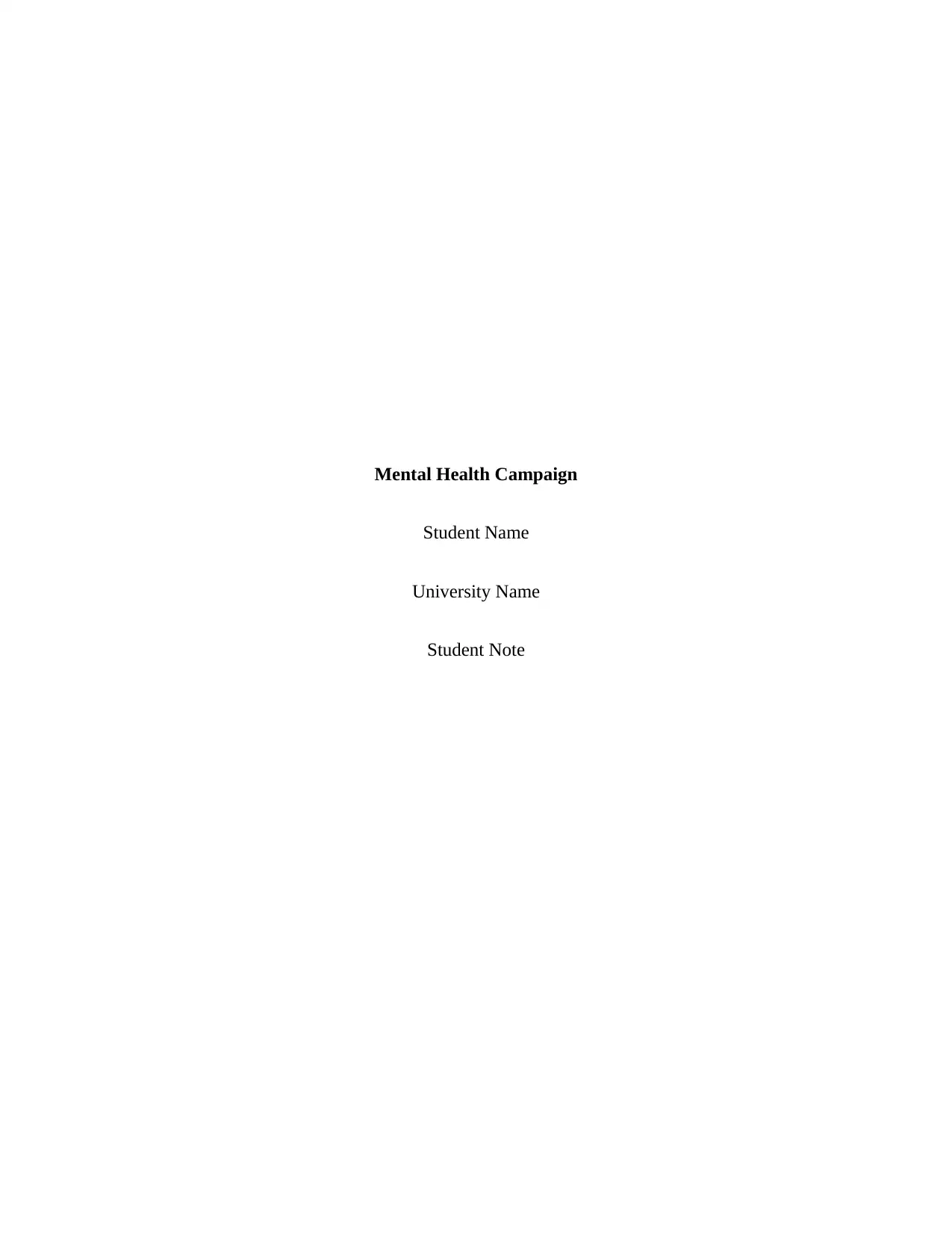
Mental Health Campaign
Student Name
University Name
Student Note
Student Name
University Name
Student Note
Paraphrase This Document
Need a fresh take? Get an instant paraphrase of this document with our AI Paraphraser
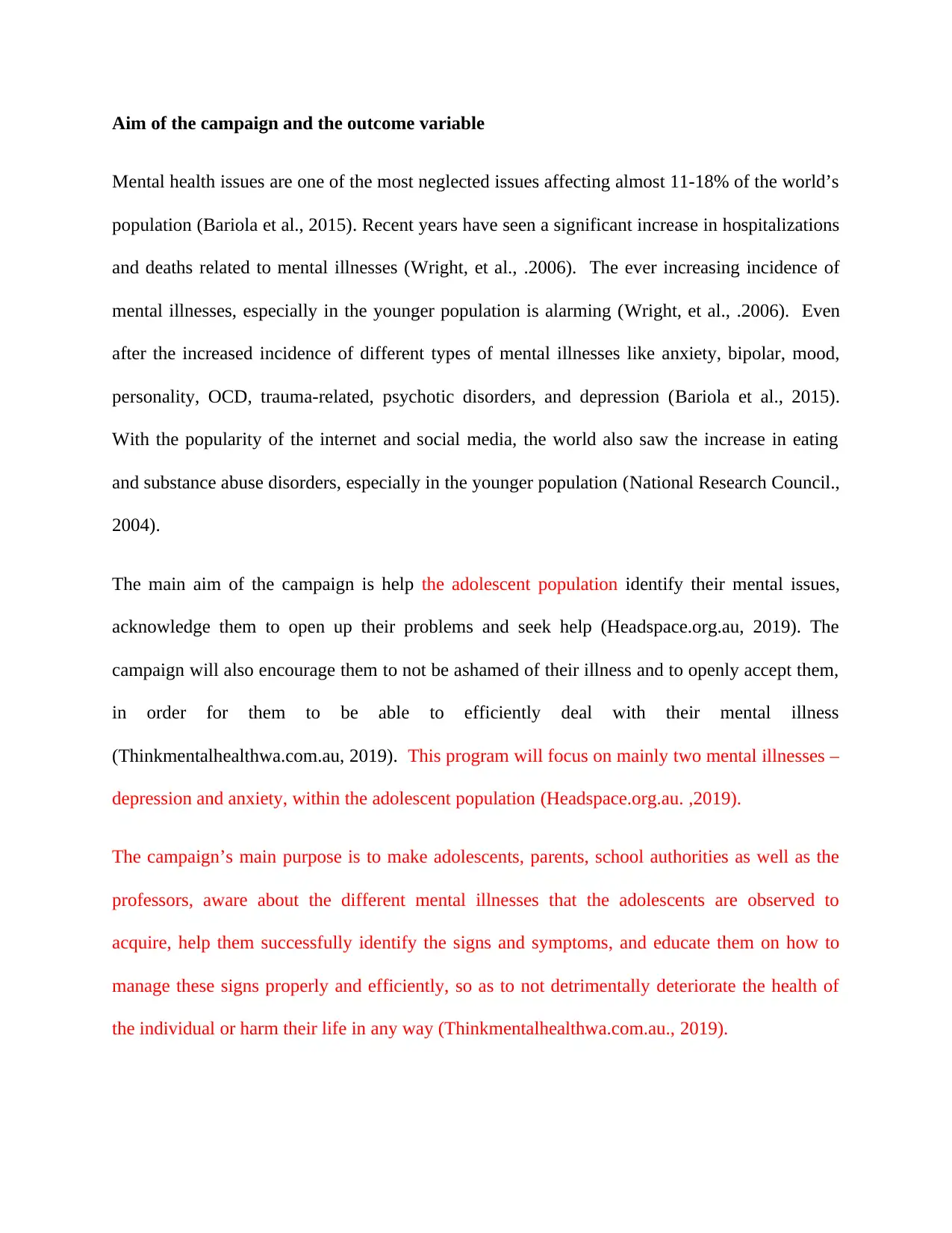
Aim of the campaign and the outcome variable
Mental health issues are one of the most neglected issues affecting almost 11-18% of the world’s
population (Bariola et al., 2015). Recent years have seen a significant increase in hospitalizations
and deaths related to mental illnesses (Wright, et al., .2006). The ever increasing incidence of
mental illnesses, especially in the younger population is alarming (Wright, et al., .2006). Even
after the increased incidence of different types of mental illnesses like anxiety, bipolar, mood,
personality, OCD, trauma-related, psychotic disorders, and depression (Bariola et al., 2015).
With the popularity of the internet and social media, the world also saw the increase in eating
and substance abuse disorders, especially in the younger population (National Research Council.,
2004).
The main aim of the campaign is help the adolescent population identify their mental issues,
acknowledge them to open up their problems and seek help (Headspace.org.au, 2019). The
campaign will also encourage them to not be ashamed of their illness and to openly accept them,
in order for them to be able to efficiently deal with their mental illness
(Thinkmentalhealthwa.com.au, 2019). This program will focus on mainly two mental illnesses –
depression and anxiety, within the adolescent population (Headspace.org.au. ,2019).
The campaign’s main purpose is to make adolescents, parents, school authorities as well as the
professors, aware about the different mental illnesses that the adolescents are observed to
acquire, help them successfully identify the signs and symptoms, and educate them on how to
manage these signs properly and efficiently, so as to not detrimentally deteriorate the health of
the individual or harm their life in any way (Thinkmentalhealthwa.com.au., 2019).
Mental health issues are one of the most neglected issues affecting almost 11-18% of the world’s
population (Bariola et al., 2015). Recent years have seen a significant increase in hospitalizations
and deaths related to mental illnesses (Wright, et al., .2006). The ever increasing incidence of
mental illnesses, especially in the younger population is alarming (Wright, et al., .2006). Even
after the increased incidence of different types of mental illnesses like anxiety, bipolar, mood,
personality, OCD, trauma-related, psychotic disorders, and depression (Bariola et al., 2015).
With the popularity of the internet and social media, the world also saw the increase in eating
and substance abuse disorders, especially in the younger population (National Research Council.,
2004).
The main aim of the campaign is help the adolescent population identify their mental issues,
acknowledge them to open up their problems and seek help (Headspace.org.au, 2019). The
campaign will also encourage them to not be ashamed of their illness and to openly accept them,
in order for them to be able to efficiently deal with their mental illness
(Thinkmentalhealthwa.com.au, 2019). This program will focus on mainly two mental illnesses –
depression and anxiety, within the adolescent population (Headspace.org.au. ,2019).
The campaign’s main purpose is to make adolescents, parents, school authorities as well as the
professors, aware about the different mental illnesses that the adolescents are observed to
acquire, help them successfully identify the signs and symptoms, and educate them on how to
manage these signs properly and efficiently, so as to not detrimentally deteriorate the health of
the individual or harm their life in any way (Thinkmentalhealthwa.com.au., 2019).
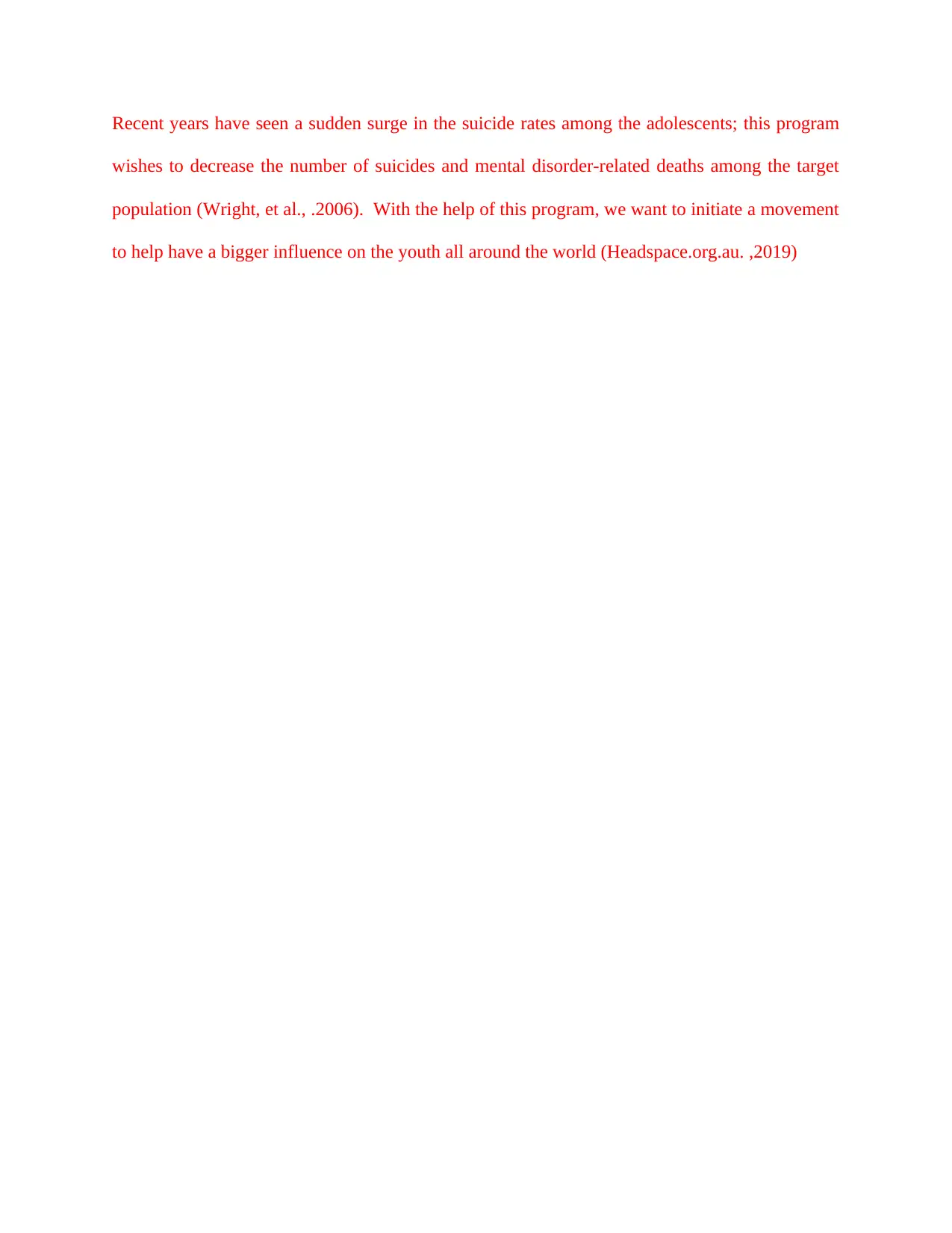
Recent years have seen a sudden surge in the suicide rates among the adolescents; this program
wishes to decrease the number of suicides and mental disorder-related deaths among the target
population (Wright, et al., .2006). With the help of this program, we want to initiate a movement
to help have a bigger influence on the youth all around the world (Headspace.org.au. ,2019)
wishes to decrease the number of suicides and mental disorder-related deaths among the target
population (Wright, et al., .2006). With the help of this program, we want to initiate a movement
to help have a bigger influence on the youth all around the world (Headspace.org.au. ,2019)
⊘ This is a preview!⊘
Do you want full access?
Subscribe today to unlock all pages.

Trusted by 1+ million students worldwide
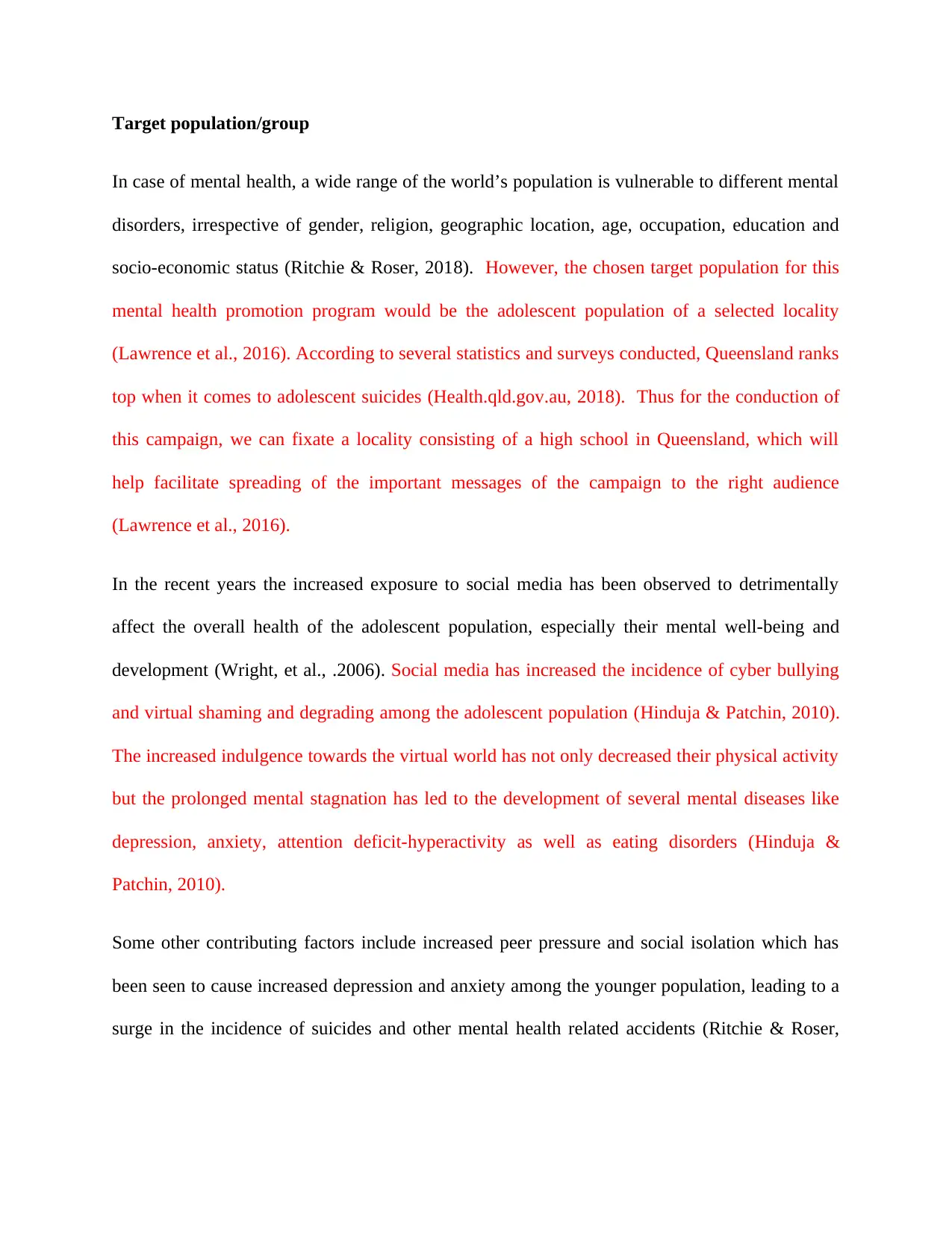
Target population/group
In case of mental health, a wide range of the world’s population is vulnerable to different mental
disorders, irrespective of gender, religion, geographic location, age, occupation, education and
socio-economic status (Ritchie & Roser, 2018). However, the chosen target population for this
mental health promotion program would be the adolescent population of a selected locality
(Lawrence et al., 2016). According to several statistics and surveys conducted, Queensland ranks
top when it comes to adolescent suicides (Health.qld.gov.au, 2018). Thus for the conduction of
this campaign, we can fixate a locality consisting of a high school in Queensland, which will
help facilitate spreading of the important messages of the campaign to the right audience
(Lawrence et al., 2016).
In the recent years the increased exposure to social media has been observed to detrimentally
affect the overall health of the adolescent population, especially their mental well-being and
development (Wright, et al., .2006). Social media has increased the incidence of cyber bullying
and virtual shaming and degrading among the adolescent population (Hinduja & Patchin, 2010).
The increased indulgence towards the virtual world has not only decreased their physical activity
but the prolonged mental stagnation has led to the development of several mental diseases like
depression, anxiety, attention deficit-hyperactivity as well as eating disorders (Hinduja &
Patchin, 2010).
Some other contributing factors include increased peer pressure and social isolation which has
been seen to cause increased depression and anxiety among the younger population, leading to a
surge in the incidence of suicides and other mental health related accidents (Ritchie & Roser,
In case of mental health, a wide range of the world’s population is vulnerable to different mental
disorders, irrespective of gender, religion, geographic location, age, occupation, education and
socio-economic status (Ritchie & Roser, 2018). However, the chosen target population for this
mental health promotion program would be the adolescent population of a selected locality
(Lawrence et al., 2016). According to several statistics and surveys conducted, Queensland ranks
top when it comes to adolescent suicides (Health.qld.gov.au, 2018). Thus for the conduction of
this campaign, we can fixate a locality consisting of a high school in Queensland, which will
help facilitate spreading of the important messages of the campaign to the right audience
(Lawrence et al., 2016).
In the recent years the increased exposure to social media has been observed to detrimentally
affect the overall health of the adolescent population, especially their mental well-being and
development (Wright, et al., .2006). Social media has increased the incidence of cyber bullying
and virtual shaming and degrading among the adolescent population (Hinduja & Patchin, 2010).
The increased indulgence towards the virtual world has not only decreased their physical activity
but the prolonged mental stagnation has led to the development of several mental diseases like
depression, anxiety, attention deficit-hyperactivity as well as eating disorders (Hinduja &
Patchin, 2010).
Some other contributing factors include increased peer pressure and social isolation which has
been seen to cause increased depression and anxiety among the younger population, leading to a
surge in the incidence of suicides and other mental health related accidents (Ritchie & Roser,
Paraphrase This Document
Need a fresh take? Get an instant paraphrase of this document with our AI Paraphraser
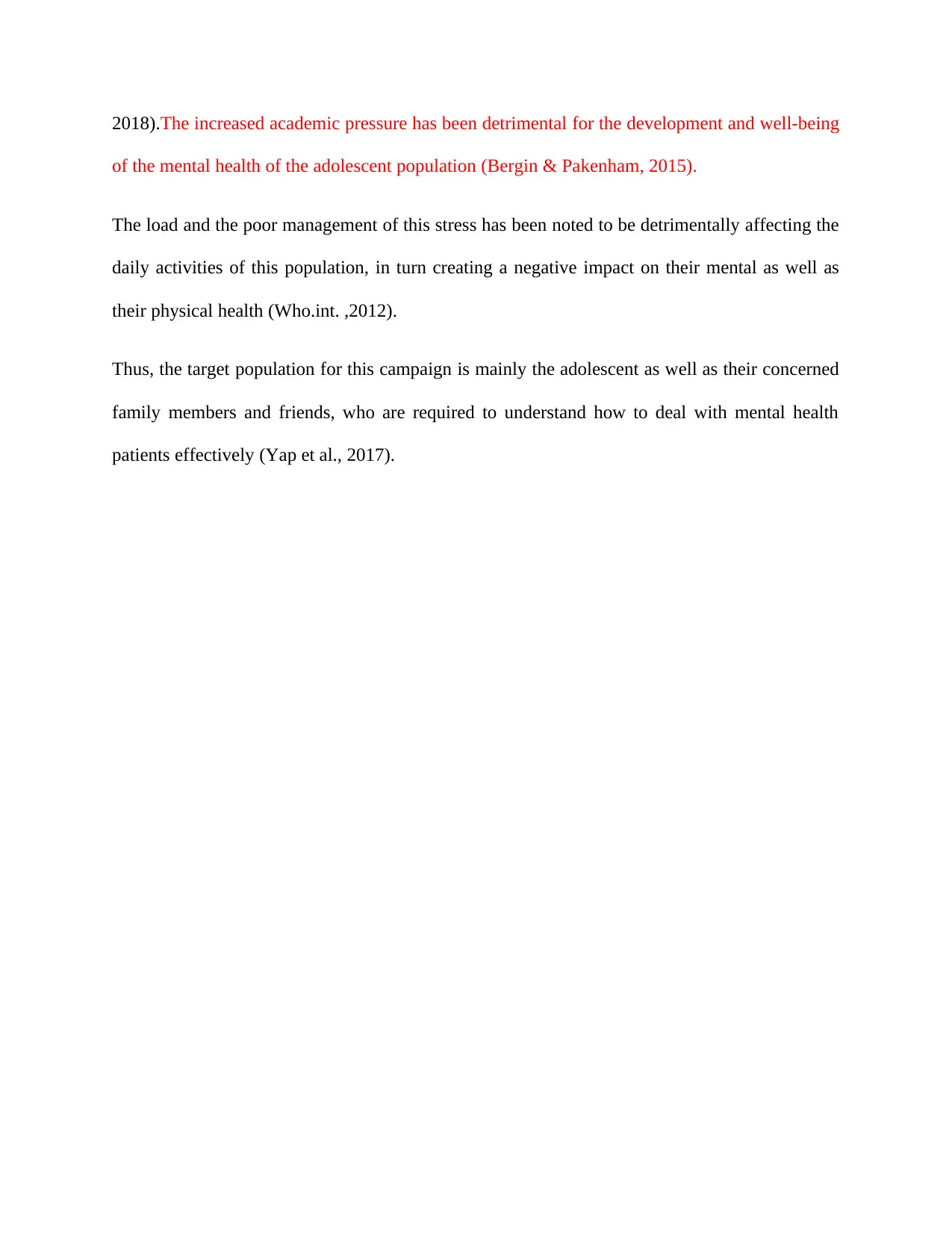
2018).The increased academic pressure has been detrimental for the development and well-being
of the mental health of the adolescent population (Bergin & Pakenham, 2015).
The load and the poor management of this stress has been noted to be detrimentally affecting the
daily activities of this population, in turn creating a negative impact on their mental as well as
their physical health (Who.int. ,2012).
Thus, the target population for this campaign is mainly the adolescent as well as their concerned
family members and friends, who are required to understand how to deal with mental health
patients effectively (Yap et al., 2017).
of the mental health of the adolescent population (Bergin & Pakenham, 2015).
The load and the poor management of this stress has been noted to be detrimentally affecting the
daily activities of this population, in turn creating a negative impact on their mental as well as
their physical health (Who.int. ,2012).
Thus, the target population for this campaign is mainly the adolescent as well as their concerned
family members and friends, who are required to understand how to deal with mental health
patients effectively (Yap et al., 2017).
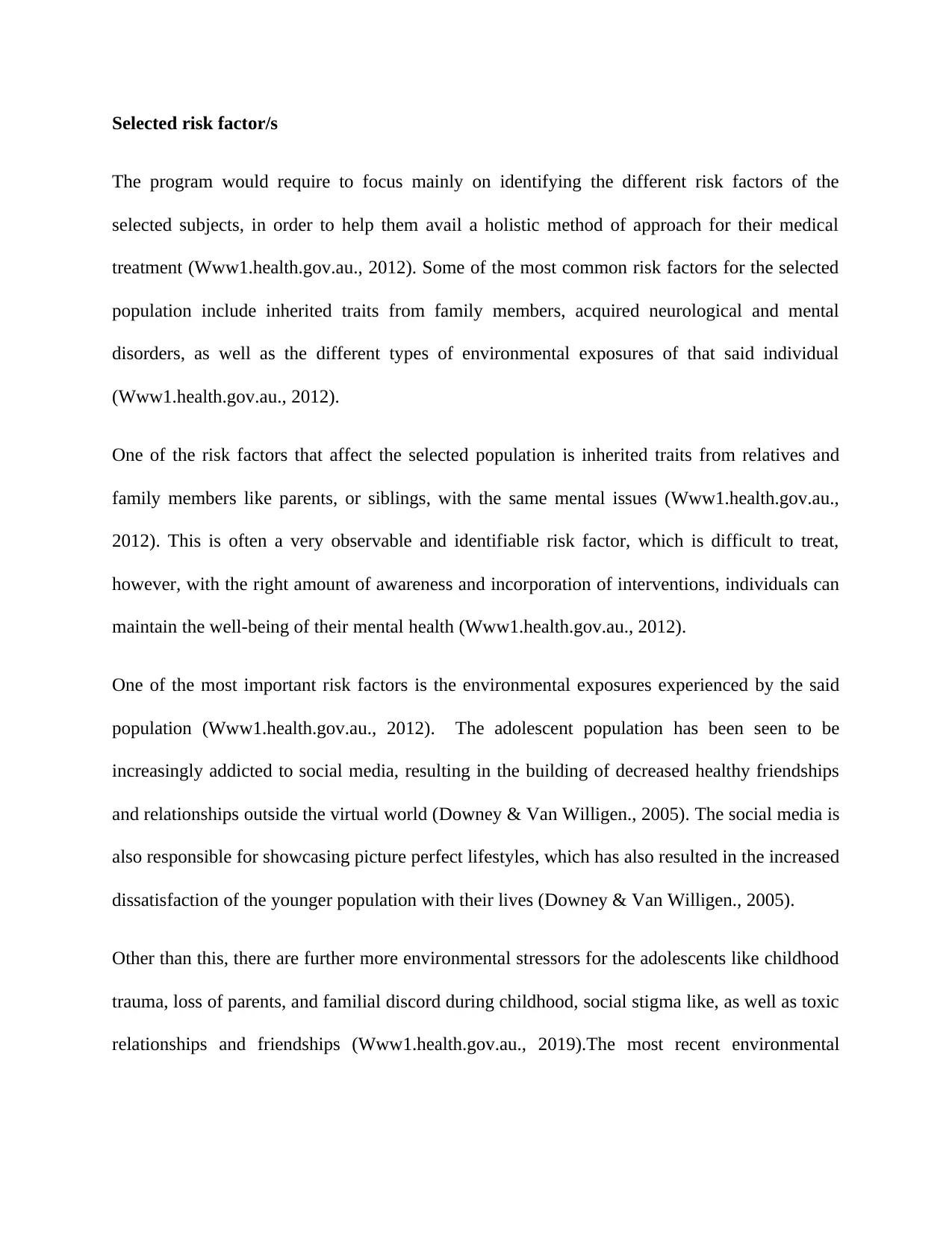
Selected risk factor/s
The program would require to focus mainly on identifying the different risk factors of the
selected subjects, in order to help them avail a holistic method of approach for their medical
treatment (Www1.health.gov.au., 2012). Some of the most common risk factors for the selected
population include inherited traits from family members, acquired neurological and mental
disorders, as well as the different types of environmental exposures of that said individual
(Www1.health.gov.au., 2012).
One of the risk factors that affect the selected population is inherited traits from relatives and
family members like parents, or siblings, with the same mental issues (Www1.health.gov.au.,
2012). This is often a very observable and identifiable risk factor, which is difficult to treat,
however, with the right amount of awareness and incorporation of interventions, individuals can
maintain the well-being of their mental health (Www1.health.gov.au., 2012).
One of the most important risk factors is the environmental exposures experienced by the said
population (Www1.health.gov.au., 2012). The adolescent population has been seen to be
increasingly addicted to social media, resulting in the building of decreased healthy friendships
and relationships outside the virtual world (Downey & Van Willigen., 2005). The social media is
also responsible for showcasing picture perfect lifestyles, which has also resulted in the increased
dissatisfaction of the younger population with their lives (Downey & Van Willigen., 2005).
Other than this, there are further more environmental stressors for the adolescents like childhood
trauma, loss of parents, and familial discord during childhood, social stigma like, as well as toxic
relationships and friendships (Www1.health.gov.au., 2019).The most recent environmental
The program would require to focus mainly on identifying the different risk factors of the
selected subjects, in order to help them avail a holistic method of approach for their medical
treatment (Www1.health.gov.au., 2012). Some of the most common risk factors for the selected
population include inherited traits from family members, acquired neurological and mental
disorders, as well as the different types of environmental exposures of that said individual
(Www1.health.gov.au., 2012).
One of the risk factors that affect the selected population is inherited traits from relatives and
family members like parents, or siblings, with the same mental issues (Www1.health.gov.au.,
2012). This is often a very observable and identifiable risk factor, which is difficult to treat,
however, with the right amount of awareness and incorporation of interventions, individuals can
maintain the well-being of their mental health (Www1.health.gov.au., 2012).
One of the most important risk factors is the environmental exposures experienced by the said
population (Www1.health.gov.au., 2012). The adolescent population has been seen to be
increasingly addicted to social media, resulting in the building of decreased healthy friendships
and relationships outside the virtual world (Downey & Van Willigen., 2005). The social media is
also responsible for showcasing picture perfect lifestyles, which has also resulted in the increased
dissatisfaction of the younger population with their lives (Downey & Van Willigen., 2005).
Other than this, there are further more environmental stressors for the adolescents like childhood
trauma, loss of parents, and familial discord during childhood, social stigma like, as well as toxic
relationships and friendships (Www1.health.gov.au., 2019).The most recent environmental
⊘ This is a preview!⊘
Do you want full access?
Subscribe today to unlock all pages.

Trusted by 1+ million students worldwide
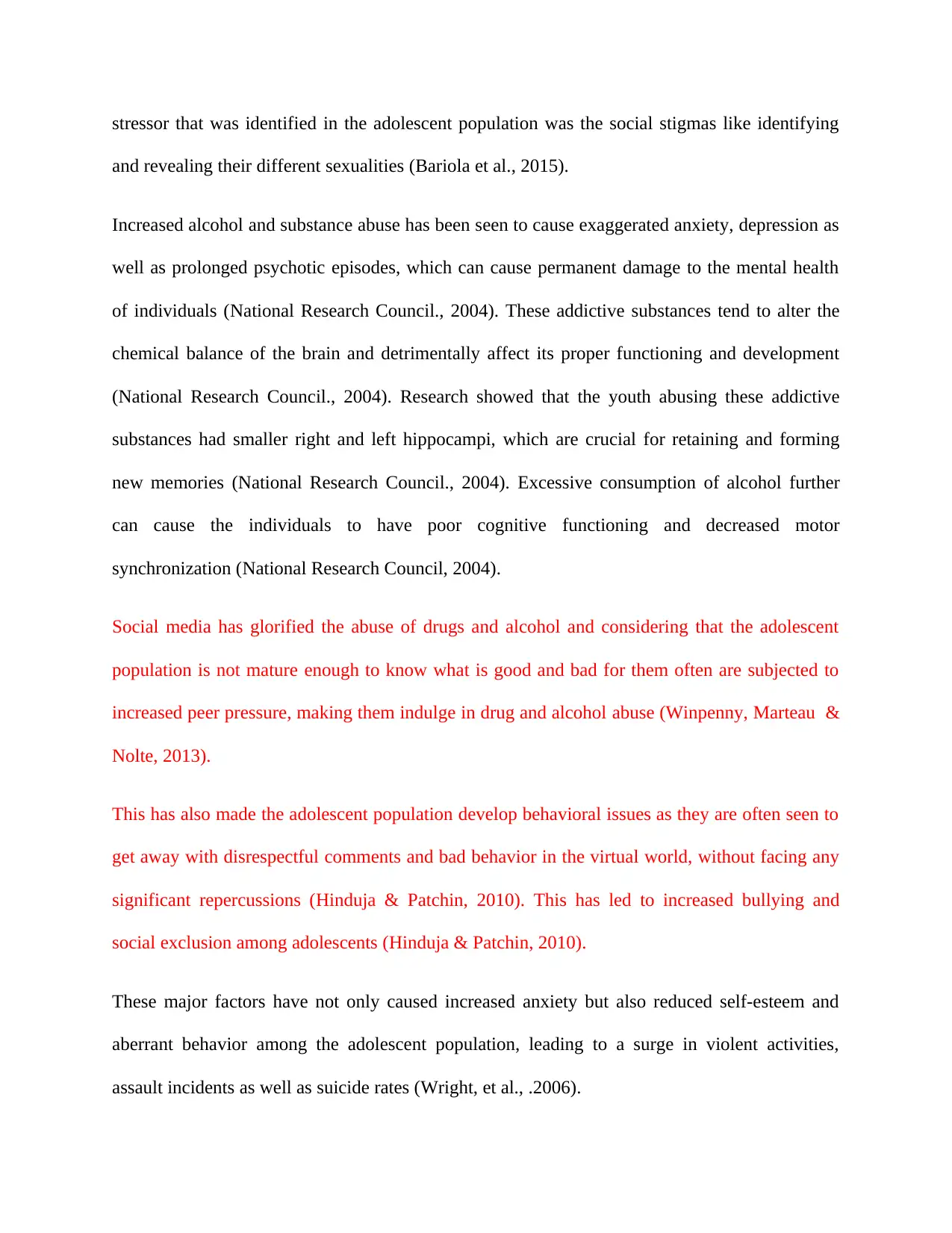
stressor that was identified in the adolescent population was the social stigmas like identifying
and revealing their different sexualities (Bariola et al., 2015).
Increased alcohol and substance abuse has been seen to cause exaggerated anxiety, depression as
well as prolonged psychotic episodes, which can cause permanent damage to the mental health
of individuals (National Research Council., 2004). These addictive substances tend to alter the
chemical balance of the brain and detrimentally affect its proper functioning and development
(National Research Council., 2004). Research showed that the youth abusing these addictive
substances had smaller right and left hippocampi, which are crucial for retaining and forming
new memories (National Research Council., 2004). Excessive consumption of alcohol further
can cause the individuals to have poor cognitive functioning and decreased motor
synchronization (National Research Council, 2004).
Social media has glorified the abuse of drugs and alcohol and considering that the adolescent
population is not mature enough to know what is good and bad for them often are subjected to
increased peer pressure, making them indulge in drug and alcohol abuse (Winpenny, Marteau &
Nolte, 2013).
This has also made the adolescent population develop behavioral issues as they are often seen to
get away with disrespectful comments and bad behavior in the virtual world, without facing any
significant repercussions (Hinduja & Patchin, 2010). This has led to increased bullying and
social exclusion among adolescents (Hinduja & Patchin, 2010).
These major factors have not only caused increased anxiety but also reduced self-esteem and
aberrant behavior among the adolescent population, leading to a surge in violent activities,
assault incidents as well as suicide rates (Wright, et al., .2006).
and revealing their different sexualities (Bariola et al., 2015).
Increased alcohol and substance abuse has been seen to cause exaggerated anxiety, depression as
well as prolonged psychotic episodes, which can cause permanent damage to the mental health
of individuals (National Research Council., 2004). These addictive substances tend to alter the
chemical balance of the brain and detrimentally affect its proper functioning and development
(National Research Council., 2004). Research showed that the youth abusing these addictive
substances had smaller right and left hippocampi, which are crucial for retaining and forming
new memories (National Research Council., 2004). Excessive consumption of alcohol further
can cause the individuals to have poor cognitive functioning and decreased motor
synchronization (National Research Council, 2004).
Social media has glorified the abuse of drugs and alcohol and considering that the adolescent
population is not mature enough to know what is good and bad for them often are subjected to
increased peer pressure, making them indulge in drug and alcohol abuse (Winpenny, Marteau &
Nolte, 2013).
This has also made the adolescent population develop behavioral issues as they are often seen to
get away with disrespectful comments and bad behavior in the virtual world, without facing any
significant repercussions (Hinduja & Patchin, 2010). This has led to increased bullying and
social exclusion among adolescents (Hinduja & Patchin, 2010).
These major factors have not only caused increased anxiety but also reduced self-esteem and
aberrant behavior among the adolescent population, leading to a surge in violent activities,
assault incidents as well as suicide rates (Wright, et al., .2006).
Paraphrase This Document
Need a fresh take? Get an instant paraphrase of this document with our AI Paraphraser
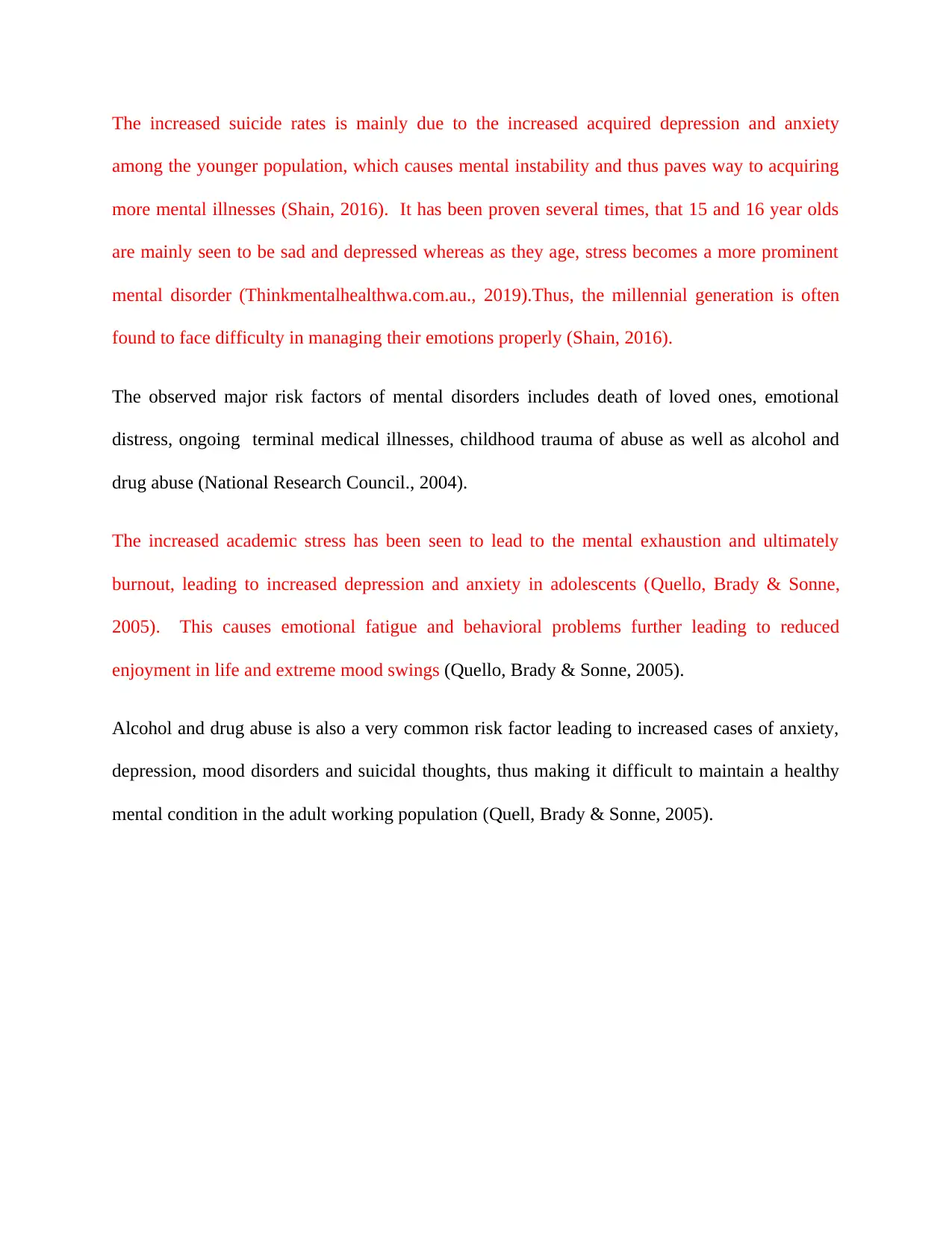
The increased suicide rates is mainly due to the increased acquired depression and anxiety
among the younger population, which causes mental instability and thus paves way to acquiring
more mental illnesses (Shain, 2016). It has been proven several times, that 15 and 16 year olds
are mainly seen to be sad and depressed whereas as they age, stress becomes a more prominent
mental disorder (Thinkmentalhealthwa.com.au., 2019).Thus, the millennial generation is often
found to face difficulty in managing their emotions properly (Shain, 2016).
The observed major risk factors of mental disorders includes death of loved ones, emotional
distress, ongoing terminal medical illnesses, childhood trauma of abuse as well as alcohol and
drug abuse (National Research Council., 2004).
The increased academic stress has been seen to lead to the mental exhaustion and ultimately
burnout, leading to increased depression and anxiety in adolescents (Quello, Brady & Sonne,
2005). This causes emotional fatigue and behavioral problems further leading to reduced
enjoyment in life and extreme mood swings (Quello, Brady & Sonne, 2005).
Alcohol and drug abuse is also a very common risk factor leading to increased cases of anxiety,
depression, mood disorders and suicidal thoughts, thus making it difficult to maintain a healthy
mental condition in the adult working population (Quell, Brady & Sonne, 2005).
among the younger population, which causes mental instability and thus paves way to acquiring
more mental illnesses (Shain, 2016). It has been proven several times, that 15 and 16 year olds
are mainly seen to be sad and depressed whereas as they age, stress becomes a more prominent
mental disorder (Thinkmentalhealthwa.com.au., 2019).Thus, the millennial generation is often
found to face difficulty in managing their emotions properly (Shain, 2016).
The observed major risk factors of mental disorders includes death of loved ones, emotional
distress, ongoing terminal medical illnesses, childhood trauma of abuse as well as alcohol and
drug abuse (National Research Council., 2004).
The increased academic stress has been seen to lead to the mental exhaustion and ultimately
burnout, leading to increased depression and anxiety in adolescents (Quello, Brady & Sonne,
2005). This causes emotional fatigue and behavioral problems further leading to reduced
enjoyment in life and extreme mood swings (Quello, Brady & Sonne, 2005).
Alcohol and drug abuse is also a very common risk factor leading to increased cases of anxiety,
depression, mood disorders and suicidal thoughts, thus making it difficult to maintain a healthy
mental condition in the adult working population (Quell, Brady & Sonne, 2005).
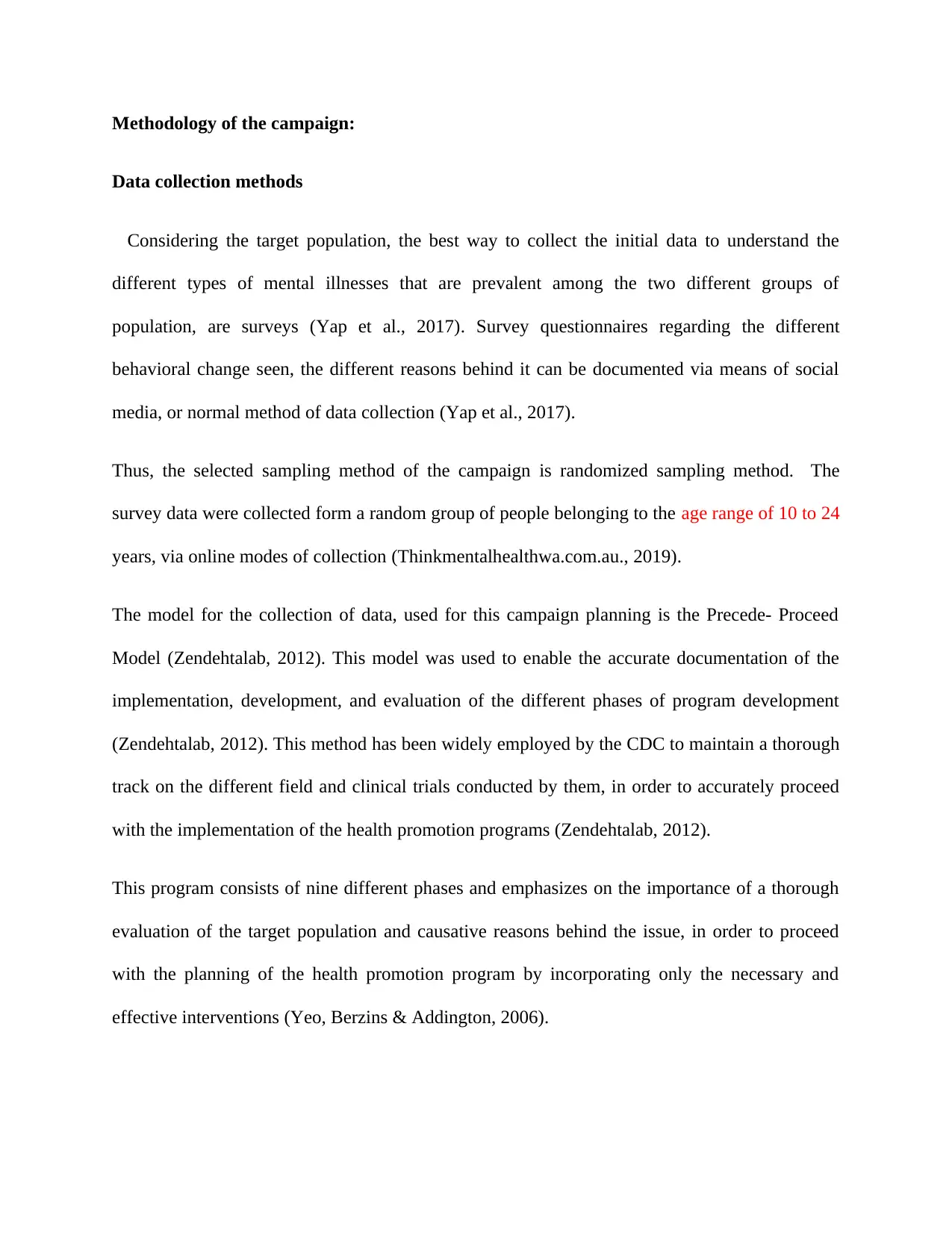
Methodology of the campaign:
Data collection methods
Considering the target population, the best way to collect the initial data to understand the
different types of mental illnesses that are prevalent among the two different groups of
population, are surveys (Yap et al., 2017). Survey questionnaires regarding the different
behavioral change seen, the different reasons behind it can be documented via means of social
media, or normal method of data collection (Yap et al., 2017).
Thus, the selected sampling method of the campaign is randomized sampling method. The
survey data were collected form a random group of people belonging to the age range of 10 to 24
years, via online modes of collection (Thinkmentalhealthwa.com.au., 2019).
The model for the collection of data, used for this campaign planning is the Precede- Proceed
Model (Zendehtalab, 2012). This model was used to enable the accurate documentation of the
implementation, development, and evaluation of the different phases of program development
(Zendehtalab, 2012). This method has been widely employed by the CDC to maintain a thorough
track on the different field and clinical trials conducted by them, in order to accurately proceed
with the implementation of the health promotion programs (Zendehtalab, 2012).
This program consists of nine different phases and emphasizes on the importance of a thorough
evaluation of the target population and causative reasons behind the issue, in order to proceed
with the planning of the health promotion program by incorporating only the necessary and
effective interventions (Yeo, Berzins & Addington, 2006).
Data collection methods
Considering the target population, the best way to collect the initial data to understand the
different types of mental illnesses that are prevalent among the two different groups of
population, are surveys (Yap et al., 2017). Survey questionnaires regarding the different
behavioral change seen, the different reasons behind it can be documented via means of social
media, or normal method of data collection (Yap et al., 2017).
Thus, the selected sampling method of the campaign is randomized sampling method. The
survey data were collected form a random group of people belonging to the age range of 10 to 24
years, via online modes of collection (Thinkmentalhealthwa.com.au., 2019).
The model for the collection of data, used for this campaign planning is the Precede- Proceed
Model (Zendehtalab, 2012). This model was used to enable the accurate documentation of the
implementation, development, and evaluation of the different phases of program development
(Zendehtalab, 2012). This method has been widely employed by the CDC to maintain a thorough
track on the different field and clinical trials conducted by them, in order to accurately proceed
with the implementation of the health promotion programs (Zendehtalab, 2012).
This program consists of nine different phases and emphasizes on the importance of a thorough
evaluation of the target population and causative reasons behind the issue, in order to proceed
with the planning of the health promotion program by incorporating only the necessary and
effective interventions (Yeo, Berzins & Addington, 2006).
⊘ This is a preview!⊘
Do you want full access?
Subscribe today to unlock all pages.

Trusted by 1+ million students worldwide
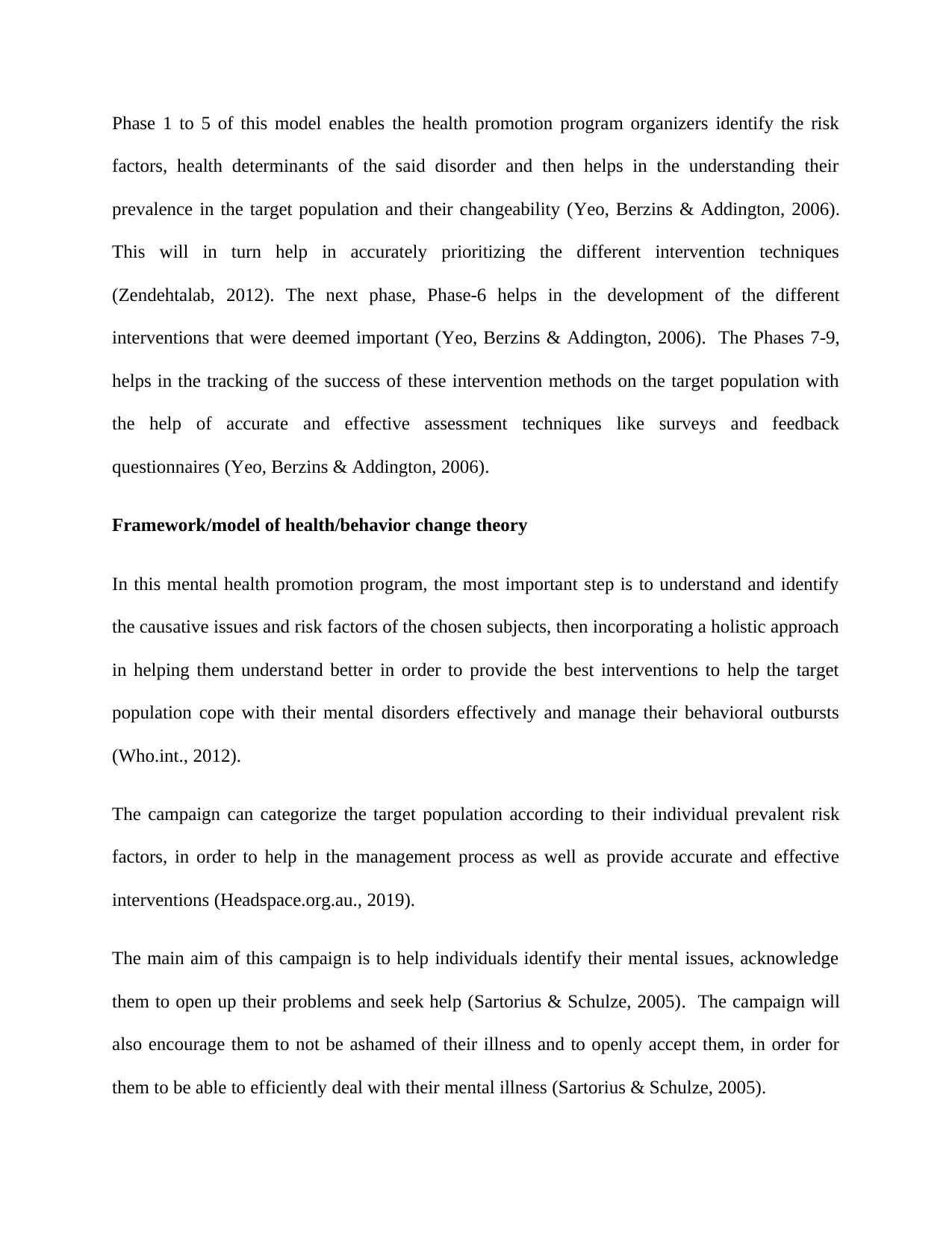
Phase 1 to 5 of this model enables the health promotion program organizers identify the risk
factors, health determinants of the said disorder and then helps in the understanding their
prevalence in the target population and their changeability (Yeo, Berzins & Addington, 2006).
This will in turn help in accurately prioritizing the different intervention techniques
(Zendehtalab, 2012). The next phase, Phase-6 helps in the development of the different
interventions that were deemed important (Yeo, Berzins & Addington, 2006). The Phases 7-9,
helps in the tracking of the success of these intervention methods on the target population with
the help of accurate and effective assessment techniques like surveys and feedback
questionnaires (Yeo, Berzins & Addington, 2006).
Framework/model of health/behavior change theory
In this mental health promotion program, the most important step is to understand and identify
the causative issues and risk factors of the chosen subjects, then incorporating a holistic approach
in helping them understand better in order to provide the best interventions to help the target
population cope with their mental disorders effectively and manage their behavioral outbursts
(Who.int., 2012).
The campaign can categorize the target population according to their individual prevalent risk
factors, in order to help in the management process as well as provide accurate and effective
interventions (Headspace.org.au., 2019).
The main aim of this campaign is to help individuals identify their mental issues, acknowledge
them to open up their problems and seek help (Sartorius & Schulze, 2005). The campaign will
also encourage them to not be ashamed of their illness and to openly accept them, in order for
them to be able to efficiently deal with their mental illness (Sartorius & Schulze, 2005).
factors, health determinants of the said disorder and then helps in the understanding their
prevalence in the target population and their changeability (Yeo, Berzins & Addington, 2006).
This will in turn help in accurately prioritizing the different intervention techniques
(Zendehtalab, 2012). The next phase, Phase-6 helps in the development of the different
interventions that were deemed important (Yeo, Berzins & Addington, 2006). The Phases 7-9,
helps in the tracking of the success of these intervention methods on the target population with
the help of accurate and effective assessment techniques like surveys and feedback
questionnaires (Yeo, Berzins & Addington, 2006).
Framework/model of health/behavior change theory
In this mental health promotion program, the most important step is to understand and identify
the causative issues and risk factors of the chosen subjects, then incorporating a holistic approach
in helping them understand better in order to provide the best interventions to help the target
population cope with their mental disorders effectively and manage their behavioral outbursts
(Who.int., 2012).
The campaign can categorize the target population according to their individual prevalent risk
factors, in order to help in the management process as well as provide accurate and effective
interventions (Headspace.org.au., 2019).
The main aim of this campaign is to help individuals identify their mental issues, acknowledge
them to open up their problems and seek help (Sartorius & Schulze, 2005). The campaign will
also encourage them to not be ashamed of their illness and to openly accept them, in order for
them to be able to efficiently deal with their mental illness (Sartorius & Schulze, 2005).
Paraphrase This Document
Need a fresh take? Get an instant paraphrase of this document with our AI Paraphraser
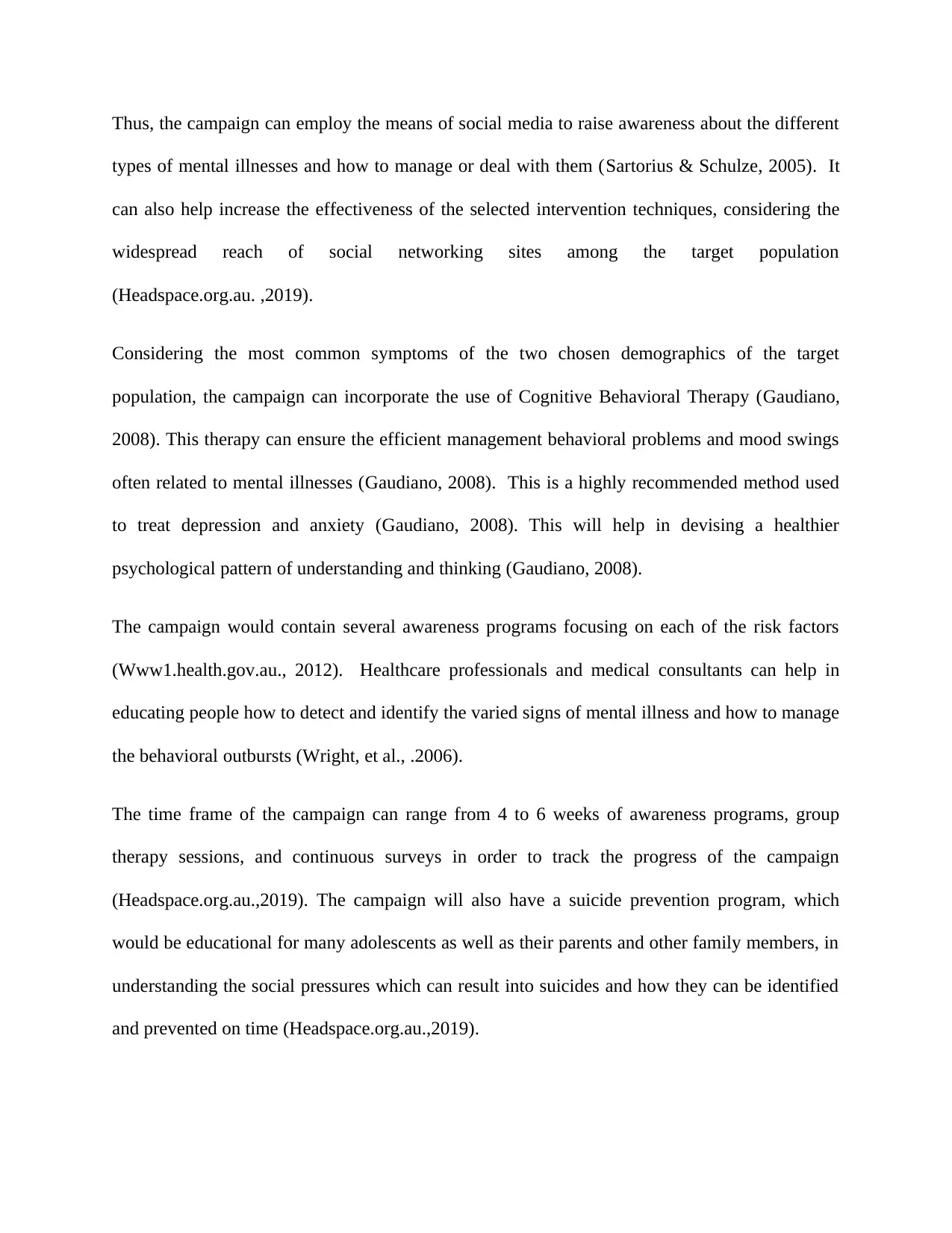
Thus, the campaign can employ the means of social media to raise awareness about the different
types of mental illnesses and how to manage or deal with them (Sartorius & Schulze, 2005). It
can also help increase the effectiveness of the selected intervention techniques, considering the
widespread reach of social networking sites among the target population
(Headspace.org.au. ,2019).
Considering the most common symptoms of the two chosen demographics of the target
population, the campaign can incorporate the use of Cognitive Behavioral Therapy (Gaudiano,
2008). This therapy can ensure the efficient management behavioral problems and mood swings
often related to mental illnesses (Gaudiano, 2008). This is a highly recommended method used
to treat depression and anxiety (Gaudiano, 2008). This will help in devising a healthier
psychological pattern of understanding and thinking (Gaudiano, 2008).
The campaign would contain several awareness programs focusing on each of the risk factors
(Www1.health.gov.au., 2012). Healthcare professionals and medical consultants can help in
educating people how to detect and identify the varied signs of mental illness and how to manage
the behavioral outbursts (Wright, et al., .2006).
The time frame of the campaign can range from 4 to 6 weeks of awareness programs, group
therapy sessions, and continuous surveys in order to track the progress of the campaign
(Headspace.org.au.,2019). The campaign will also have a suicide prevention program, which
would be educational for many adolescents as well as their parents and other family members, in
understanding the social pressures which can result into suicides and how they can be identified
and prevented on time (Headspace.org.au.,2019).
types of mental illnesses and how to manage or deal with them (Sartorius & Schulze, 2005). It
can also help increase the effectiveness of the selected intervention techniques, considering the
widespread reach of social networking sites among the target population
(Headspace.org.au. ,2019).
Considering the most common symptoms of the two chosen demographics of the target
population, the campaign can incorporate the use of Cognitive Behavioral Therapy (Gaudiano,
2008). This therapy can ensure the efficient management behavioral problems and mood swings
often related to mental illnesses (Gaudiano, 2008). This is a highly recommended method used
to treat depression and anxiety (Gaudiano, 2008). This will help in devising a healthier
psychological pattern of understanding and thinking (Gaudiano, 2008).
The campaign would contain several awareness programs focusing on each of the risk factors
(Www1.health.gov.au., 2012). Healthcare professionals and medical consultants can help in
educating people how to detect and identify the varied signs of mental illness and how to manage
the behavioral outbursts (Wright, et al., .2006).
The time frame of the campaign can range from 4 to 6 weeks of awareness programs, group
therapy sessions, and continuous surveys in order to track the progress of the campaign
(Headspace.org.au.,2019). The campaign will also have a suicide prevention program, which
would be educational for many adolescents as well as their parents and other family members, in
understanding the social pressures which can result into suicides and how they can be identified
and prevented on time (Headspace.org.au.,2019).
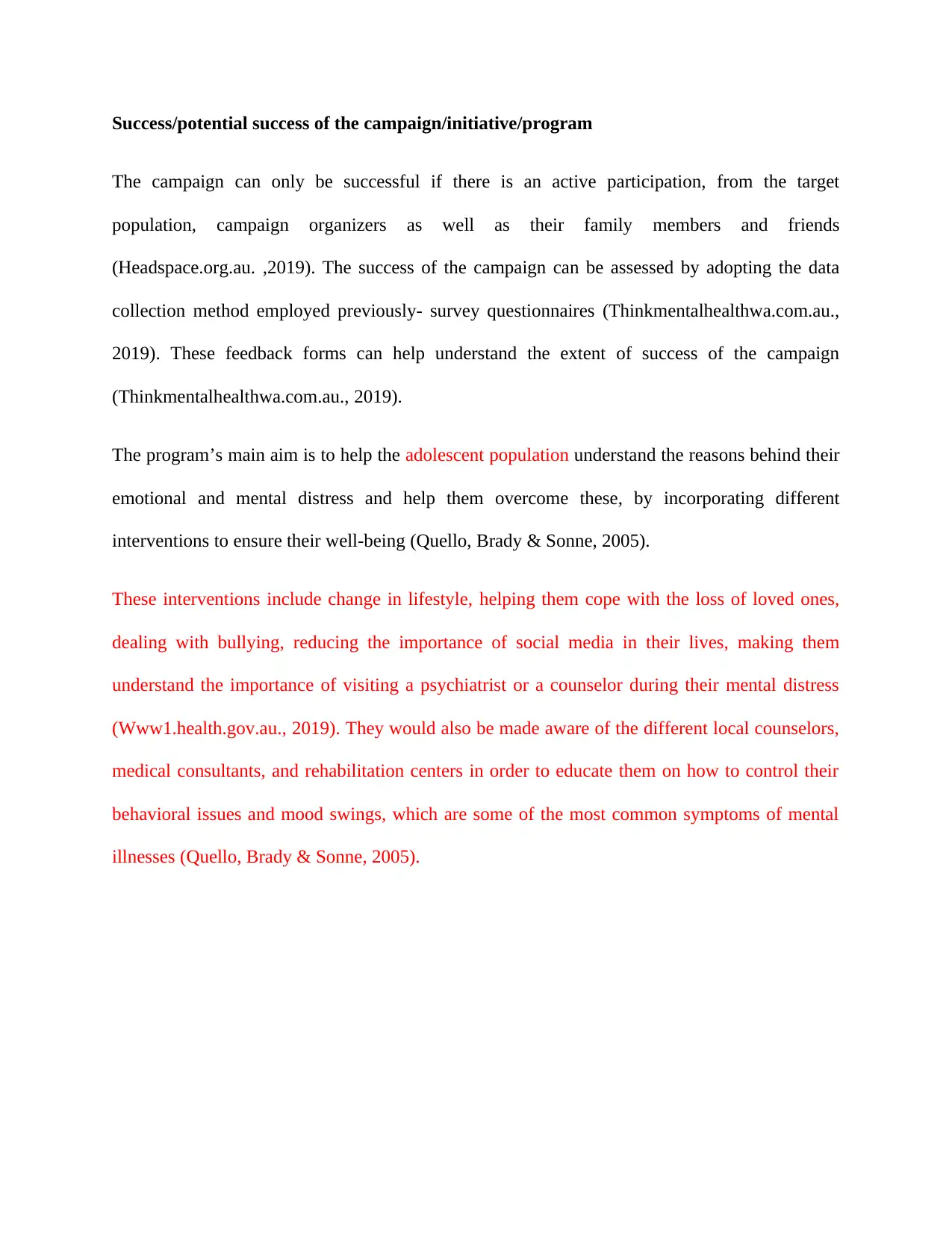
Success/potential success of the campaign/initiative/program
The campaign can only be successful if there is an active participation, from the target
population, campaign organizers as well as their family members and friends
(Headspace.org.au. ,2019). The success of the campaign can be assessed by adopting the data
collection method employed previously- survey questionnaires (Thinkmentalhealthwa.com.au.,
2019). These feedback forms can help understand the extent of success of the campaign
(Thinkmentalhealthwa.com.au., 2019).
The program’s main aim is to help the adolescent population understand the reasons behind their
emotional and mental distress and help them overcome these, by incorporating different
interventions to ensure their well-being (Quello, Brady & Sonne, 2005).
These interventions include change in lifestyle, helping them cope with the loss of loved ones,
dealing with bullying, reducing the importance of social media in their lives, making them
understand the importance of visiting a psychiatrist or a counselor during their mental distress
(Www1.health.gov.au., 2019). They would also be made aware of the different local counselors,
medical consultants, and rehabilitation centers in order to educate them on how to control their
behavioral issues and mood swings, which are some of the most common symptoms of mental
illnesses (Quello, Brady & Sonne, 2005).
The campaign can only be successful if there is an active participation, from the target
population, campaign organizers as well as their family members and friends
(Headspace.org.au. ,2019). The success of the campaign can be assessed by adopting the data
collection method employed previously- survey questionnaires (Thinkmentalhealthwa.com.au.,
2019). These feedback forms can help understand the extent of success of the campaign
(Thinkmentalhealthwa.com.au., 2019).
The program’s main aim is to help the adolescent population understand the reasons behind their
emotional and mental distress and help them overcome these, by incorporating different
interventions to ensure their well-being (Quello, Brady & Sonne, 2005).
These interventions include change in lifestyle, helping them cope with the loss of loved ones,
dealing with bullying, reducing the importance of social media in their lives, making them
understand the importance of visiting a psychiatrist or a counselor during their mental distress
(Www1.health.gov.au., 2019). They would also be made aware of the different local counselors,
medical consultants, and rehabilitation centers in order to educate them on how to control their
behavioral issues and mood swings, which are some of the most common symptoms of mental
illnesses (Quello, Brady & Sonne, 2005).
⊘ This is a preview!⊘
Do you want full access?
Subscribe today to unlock all pages.

Trusted by 1+ million students worldwide
1 out of 15
Related Documents
Your All-in-One AI-Powered Toolkit for Academic Success.
+13062052269
info@desklib.com
Available 24*7 on WhatsApp / Email
![[object Object]](/_next/static/media/star-bottom.7253800d.svg)
Unlock your academic potential
Copyright © 2020–2025 A2Z Services. All Rights Reserved. Developed and managed by ZUCOL.





